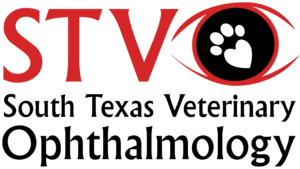FREQUENTLY ASKED QUESTIONS
ACVO (www.acvo.org) is a professional organization that has established the certifying criteria for these specialized vets. According to the ACVO, there are 352 active veterinary ophthalmologists in the United States, and Dr. Greller and Dr. Fritz are the only two board-certified veterinary ophthalmologists here in San Antonio. An ACVO-certified veterinary ophthalmologist – like Dr. Greller and Dr. Fritz – completed college (4 years) and veterinary school (4 years), and then a 1-year internship in small animal medicine and surgery and then a 3-year residency in ophthalmology is required, either at a veterinary teaching hospital or a clinic. Finally, the candidate must sit for and pass the very challenging 4-day written, oral ophthalmic and live surgical examination portions in order to call themselves Diplomates of the American College of Veterinary Ophthalmologists.
Your pet should see a board-certified ophthalmologist when their eyes are not improving with standard therapy, or the diagnosis includes emergencies such as corneal or lens lacerations, intraocular bleeding, uveitis, deep corneal ulceration, glaucoma, sudden blindness, or cataracts. We encourage veterinarians to contact STVO when their client issues are beyond the scope of typical therapy. At all times, we work in conjunction with your regular veterinarian to ensure your pet receives the best possible care.
Dr. Greller, Dr. Fritz and Dr. Darden will establish both verbal and written communications with your primary veterinarian to discuss the patients needs moving forward. General veterinary care will continue through your regular veterinarian, while any eye specific therapy will continue through a treatment plan by a board certified veterinary ophthalmologist.
We will give you a written estimate for ANY procedures or surgeries at your request once we have examined the patient and adequately understand the particular treatment plan best suited for your pet. If you cannot afford a particular medication or surgery, we can find the next best option for you. We do accept Care Credit and all major credit cards. Please refer to the “Resources” page on the STVO web site to learn more about Care Credit.
If your dog or cat has an emergency related to the eye, please call the general STVO phone number at (210) 962-5388 and tell the receptionists you have an ocular emergency. An STVO technician will reach out to triage your call and direct you toward the next step as well as consult with an on-call doctor when needed.
Please refer to the “Pet Owner – Visit Preparations” page on the STVO web site to get an overview of the exam process at the clinic.
Our office hours are Monday to Friday from 8:00am to 6:00pm by appointment only due to specific hours dedicated daily to ophthalmic examinations, consultations, and patient surgery.
Please call (210) 962-5388 to schedule your appointment and we will make sure to connect with your general veterinarian so he/she can fill out the necessary New Patient referral paperwork before your first visit. If you do not have a general veterinarian, we can still see your pet as long as it is not an urgent or emergency situation.
Patients seen after hours will be charged an emergency fee. Emergency patients can be seen during normal business hours that do not have a pre-scheduled appointment but will be charged an urgent fee upon arrival in addition to other diagnostic fees.
We kindly ask for a 24-hour notice for all appointment changes or cancellations.
Medications can be picked up at STVO throughout the week.
Please refer to the “Pet Owners – Visit Preparations” page on the STVO web site to get an overview of the exam process at the clinic.
We accept cash, all major credit cards, checks, and care credit for those that need some assistance. Please refer to the “Resources” page on the STVO web site to learn more about Care Credit.
This is a great question and one we are asked often. When the other eye is healthy, pets will have an EXCELLENT quality of life. If both eyes have a disease and/or are blind, your pet will usually have a GOOD quality of life. At all times, we do our best to minimize pain so your pets can live full lives and still enjoy long walks, resting, cuddling next to you, and of course eating … even after losing sight.
Please refer to the “Resources” page and “Common Eye Diseases” page for more information on how to take care of a blind pet.
This is a common concern, but rest assured, the STVO team will do everything we can to explain the post-operative care clearly with both oral and written instructions. All medications will be labeled, ordered, and a veterinary technician will personally review all of the care with you and answer all of your questions before you leave.
Please refer to the “Resources” page and the “Common Eye Diseases” page for more information on how to take care of a blind pet.
We will advise you in person during your visit as there is no better way to learn than to have our staff show you. The best tips are to get your pet off the ground at your waist level. Tuck their body (their butt) into your armpit of your non-dominant hand and use this hand to lift their chin, and use your dominant hand to administer the drop, coming from behind, over your pets head and let it drip into the eye. Try not to touch the bottle to eye itself if you can help it.
 Located in the SAVS Facility
Located in the SAVS Facility
